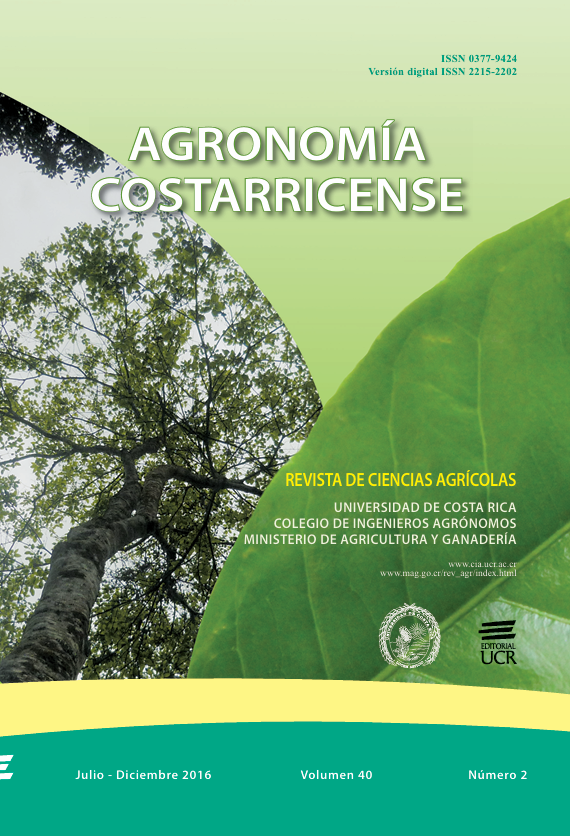Abstract
Influence of clay mineralogy, texture, and organic carbon content on the friability index of soils cultivated with sugar cane. Friability is a physical property that is essential to the mechanical management of soil and its behavior is associated with the nature of other edaphic properties; therefore, it must be investigated with integrated studies using different mineralogical, physical, and chemical properties. The effect of the predominance of the clay mineral types 1:1 and 2:1, the texture, and the organic carbon (CO) content, on the friability index (IF) of soils cultivated with sugar cane were evaluated. The IF was determined with the coefficient of variation method, using the lower limit of the confidence interval (IFi) as reference. A total of 7280 aggregates from the Ap and A1 horizons were used, taken from 18 farms located in the Valle Geográfico of the Cauca River region, Colombia. The mineralogy of the clay fraction was determined with X-ray diffraction, the granulometric distribution by the pipette method, and the CO content by the Walkley & Black method. The statistical analysis was conducted from a descriptive and inferential focus, univariate and multivariate. No significant effect from the predominance of clays 1:1 and 2:1 on the IFi response variable was found; however,higher IFi values were observed in the descriptive approach in the soils with a predominance of clays 1:1. There was no significant effect attributable to the total silt and clay fractions (FaT and FLT) on the IFi of the soils; rather, the total sand fraction (FAT) and the CO content showed highly significant effects on the IFi, with higher IFi values in the soils with higher CO contents and lower FAT contents.References
Avila, E; Leiva, F; Darghan, E; Madriñán, R. 2015. Effect of aggregate size and superficial horizon differentiation on the friability index of soils cultivated with sugar cane: a multivariate approach. Agronomía Colombiana 33(1):92-98.
Barré, P; Fernández, O; Virto, I; Velde, B; Chenu, C. 2014. Impact of phyllosilicate mineralogy on organic carbon stabilization in soils: incomplete knowledge and exciting prospects. Geoderma (235):382-395.
Barzegar, A; Oades, J; Rengasamy, P; Murray, R. 1995. Tensile strength of dry, remoulded soils as affected by properties of the clay fraction. Geoderma (65):93-108.
Bruun, T; Elberling, B; Christensen, B. 2010. Lability of soil organic carbon in tropical soils with different clay minerals. Soil Biology and Biochemistry (42):888-895.
Christensen, B. 1992. Physical fractionation of soil and organic matter in primary particle size and density separates. Advances in Soil Sciences (20):1-90.
Dexter, A; Kroesbergen, B.1985. Methodology for determination of tensile strength of soil aggregates. Journal Agriculture Engeniering Research (31):139-147.
Dexter, A; Richard, G; Arrouays, D; Czyz, E; Jolivet, C; Duval, O. 2008. Complexed organic matter controls soil physical properties. Geoderma (144):620-627.
Dexter, A; Watts, C. 2001. Tensile strength and friability. In Smith, KA; Mullins, CE. (eds.). Soil and Environmental Analysis: Physical Methods. 2 ed. Marcel Dekker Inc, New York, USA. p. 405-433.
Goldberg, S; Kapoor, B; Rhoades, J. 1990. Effect of aluminum and iron oxides and organic matter on flocculation and dispersion of arid zone soils. Soil Science (150):588- 593.
Guérif, J. 1994. Effects of compaction on soil strength parameters. Elsevier Science (Chapter 9):191-213.
Guimarães, R; Tormena, C; Alves, S; Fidalski, J; Blainski, E. 2009. Tensile strength, friability and organic carbon in an oxisol under a crop-livestock system. Scientia Agricola (Piracicaba, Brasil.) 66(4):499-505.
IGAC (Instituto Geográfico Agustín Codazzi, Colombia). 2006. Estudio Detallado de Suelos y Capacidad de Uso de las Tierras Sembradas con Caña de Azúcar en el Valle Geográfico del Río Cauca. Bogotá, Colombia. 483 p.
IGAC (Instituto Geográfico Agustín Codazzi, Colombia). 2006a. Métodos analíticos del laboratorio de suelos. Sexta edición. Bogotá, Colombia. 674 p.
Imhoff, S; Da Silva, P; Dexter, A. 2002. Factors contributing to the tensile strength and friability of Oxisols. Soil Science Society of America Journal (66):1656-1661.
Jindaluang, W; Kheoruenromne, I; Suddhiprakarn, A; Singh, B. 2013. Influence of soil texture and mineralogy on organic matter content and composition in physically separated fractions soils of Thailand. Geoderma (195):207-219.
Kay, B; Dexter, A. 1992. The influence of dispersible clay and wetting/drying cycles on the tensile strength of a red-brown earth. Australian Journal of Soil Research (30):297-310.
Macks, S; Murphy, B; Cresswell, H; Koen, T. 1996. Soil friability in relation to management history and suitability for direct drilling. Australian Journal of Soil Research (34):343-360.
Munkholm, L. 2011. Soil friability: A review of the concept, assessment and effects of soil properties and management (Review). Geoderma (167):236-246.
Munkholm, L; Heck, R; Deen, B. 2012. Soil pore characteristics assessed from X-ray micro-CT derived images and correlations to soil friability. Geoderma (181):22-29.
Oades, J. 1984. Soil organic matter and structural stability: mechanisms and implications for management. Plant and Soil (76):319-337.
SAS (Statistical Analysis System, USA). 2009. SAS user´s guide; SAS/STAT. SAS Campus Drive, Cary North Carolina Rv. 27513. p. 206.
Schjǿnning, P; De Jonge, L; Munkholm, L; Moldrup, P; Christensen, B; Olesen, J. 2011. Clay dispersibility and soil friability-testing the soil clay-to-carbon saturation concept. Soil Science Society of America Journal. Special section: Soil Architecture and Function: 174-187.
Sefeedpari, P; Shokoohi, Z; Behzadifar, Y. 2014. Energy use and carbon dioxide emission analysis in sugarcane farms: a survey on Haft-Tappeh Sugarcane Agro- Industrial Company in Iran. Journal of Cleaner Production (83):212-219.
Tormena, C; Araujo, M; Fidalsky, J; Imhoff, S; Da Silva A. 2008. Quantification of tensile strength and friability of an Oxisol (Acrudox) under no-tillage. Revista Brasilera de la Ciencia del Suelo 32(3):1-11.
USDA (United States Department of Agriculture, USA). 2010. Keys to Soil Taxonomy, Eleventh Ed. By Soil Survey Staff. Natural Resources Conservation Service. Washington, D.C. USA. p. 365.
Watts, C; Dexter, A. 1998. Soil friability: theory, measurement and the effects of management and organic carbon content. European Journal of Soil Science (49):73-84.

